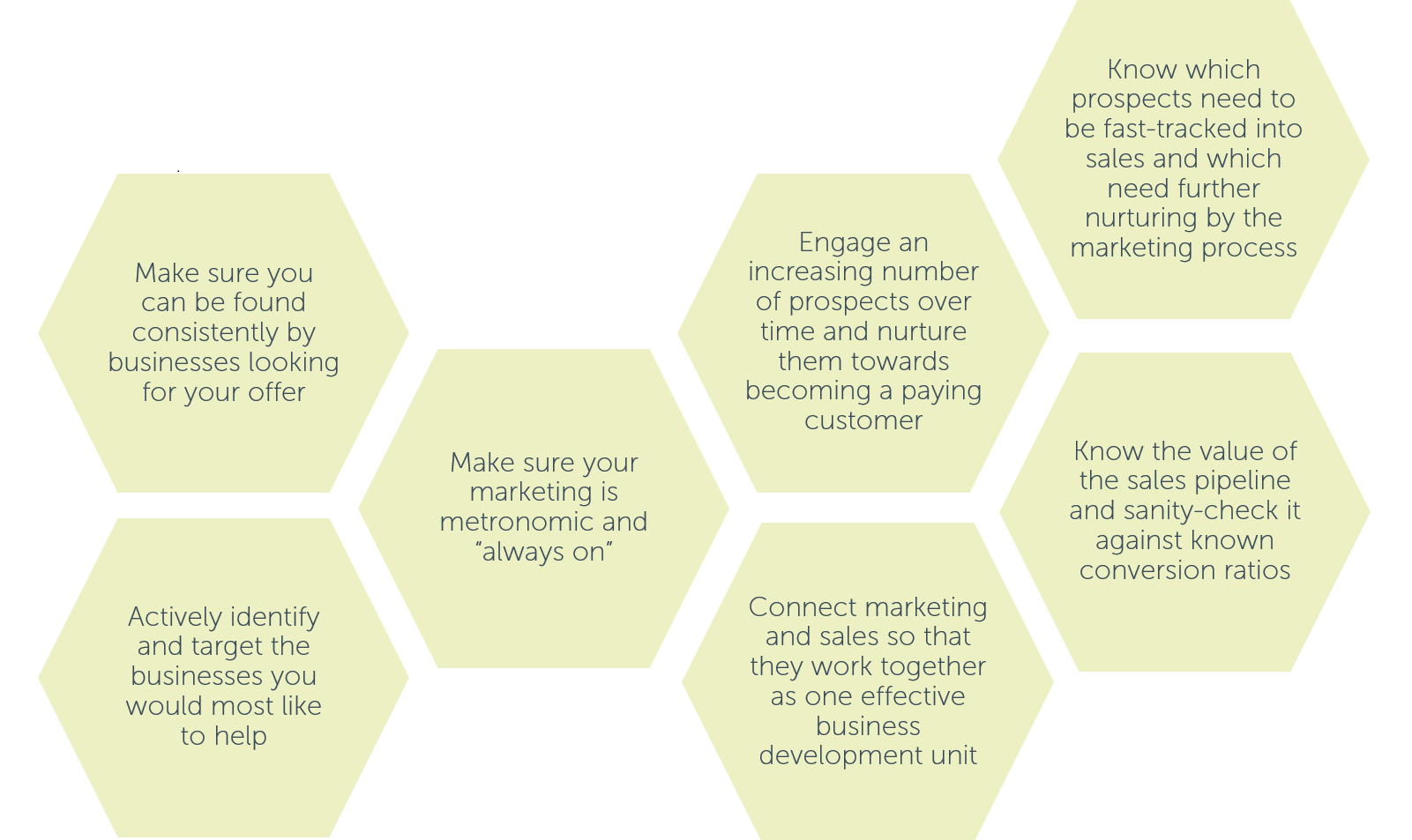7 essential components of your marketing strategy
A marketing strategy is more than just a string of campaign ideas, it has to be a sustainable, measurable process that drives sales and business growth. Here are 7 essential stepping stones to help you build a strategy for success.

1. Make sure you can ‘be found’ consistently by businesses looking for what you offer
There are people out there right now looking for the product or service you offer. Some will know exactly what they want, others will still be information gathering. Either way, you need to make sure your business is in their path. This is the role of paid search, social media, PR and advertising – tactics that, with the right targeting, will make you visible to the broadest possible relevant audience.
2. Actively identify and target the businesses you would most like to help
You should know the type of customer your product is most suited to. These people or businesses might not even recognise that they have a problem you could solve, let alone that you exist. Don’t let that stop you: it’s marketing’s job to raise awareness and build understanding of what you do. A well-focused direct marketing plan can put your messages directly in front of the people that matter. Here we’re talking about email marketing, direct mail, events and possibly even outbound calling.
Your plan needs to include ‘be found’ and ‘go find’ tactics in equal measure.
3. Make sure your marketing is metronomic and always on
Stop thinking about your marketing in terms of sporadic campaigns to be actioned whenever sales suffer a dip. Instead think of it as a constant process that is working away to move prospects through the sales funnel. Top-of-funnel activities will be bringing your business to your audience’s attention and making them problem and solution aware. Middle-of-funnel activity will be turning these people into leads for later conversion and, finally, bottom-of-funnel activity will be helping convert the leads into customers. Never stop filling and nurturing the funnel.
4. Engage an increasing number of prospects over time and nurture them towards being a paying customer
Nurturing means anticipating what a buyer’s requirements are likely to be at each stage of the buying process and putting the right content in front of them at the right time. You should always be thinking about ‘accession’ or ‘how do I move this prospect to the next stage in the buying process?’ If they are ‘middle-of-funnel’, it could be case studies, explainer videos or FAQs. If they are ‘bottom-of funnel’, it could be product comparison tools, testimonials or pricing offers. Whatever is right for your business, it needs to be mapped out and the supporting content created.
5. Connect marketing and sales so that they work together as one effective business development unit
Let's all stop talking about marketing and sales as if they are separate beings from separate planets. We should be bound together as one integrated business development unit: marketing attracting attention and nurturing; sales closing the deals and passing leads back into marketing for further nurturing when required.
6. Know which prospects needs to be fast-tracked into sales, and which need further nurturing by the marketing process
This is where understanding the status of each prospect in your sales funnel will come into its own. Lead-scoring is a great way to do this. A rapid increase in the lead-score as a result of engagement with emails, visiting important pages on the website or downloading your content is a strong signal that your prospect is ready to buy now and should be contacted by sales. A slower increase suggests that the prospect isn’t quite ready. To dive in with a sales call at this stage could be fatally off-putting. Nobody likes to be sold to. More patience is needed. Instead, offer the next piece of value in your nurturing sequence and watch the impact on the lead score.
7. Know the value of your sales pipeline
Knowing the value of your sales pipeline is an essential part of knowing if you are on target or not. Don’t, however, apply the full potential value of every lead as this will be misleading. Instead, scale each lead according to its chance of conversion, which is likely to align with its position in the sales funnel (E.g. Top of funnel 5%; Bottom of funnel 75%). The conversion percentages can be fine-tuned with experience over time and this will give you a much more accurate final number.
Here to help
Please talk to us about how we can help you put these elements in place in your business. We can provide consultancy to support your own implementation, or handle the implementation and management on your behalf.
Whichever approach you choose, this should put you several steps along the path to rapid and sustained growth.

Author
Neil Edwards
Neil is a Chartered Marketer and Fellow of the Chartered Institute of Marketing with many years' experience in marketing, brand and communications.
CEO / The Marketing Eye
Related Reading

Blog: Mastering Email Engagement with Lead Gen & CRM
by Darren Coleshill, 5 minute read

Blog: How to Build a Marketing Funnel That Converts (And What to Avoid)
by Darren Coleshill, 6 minute read